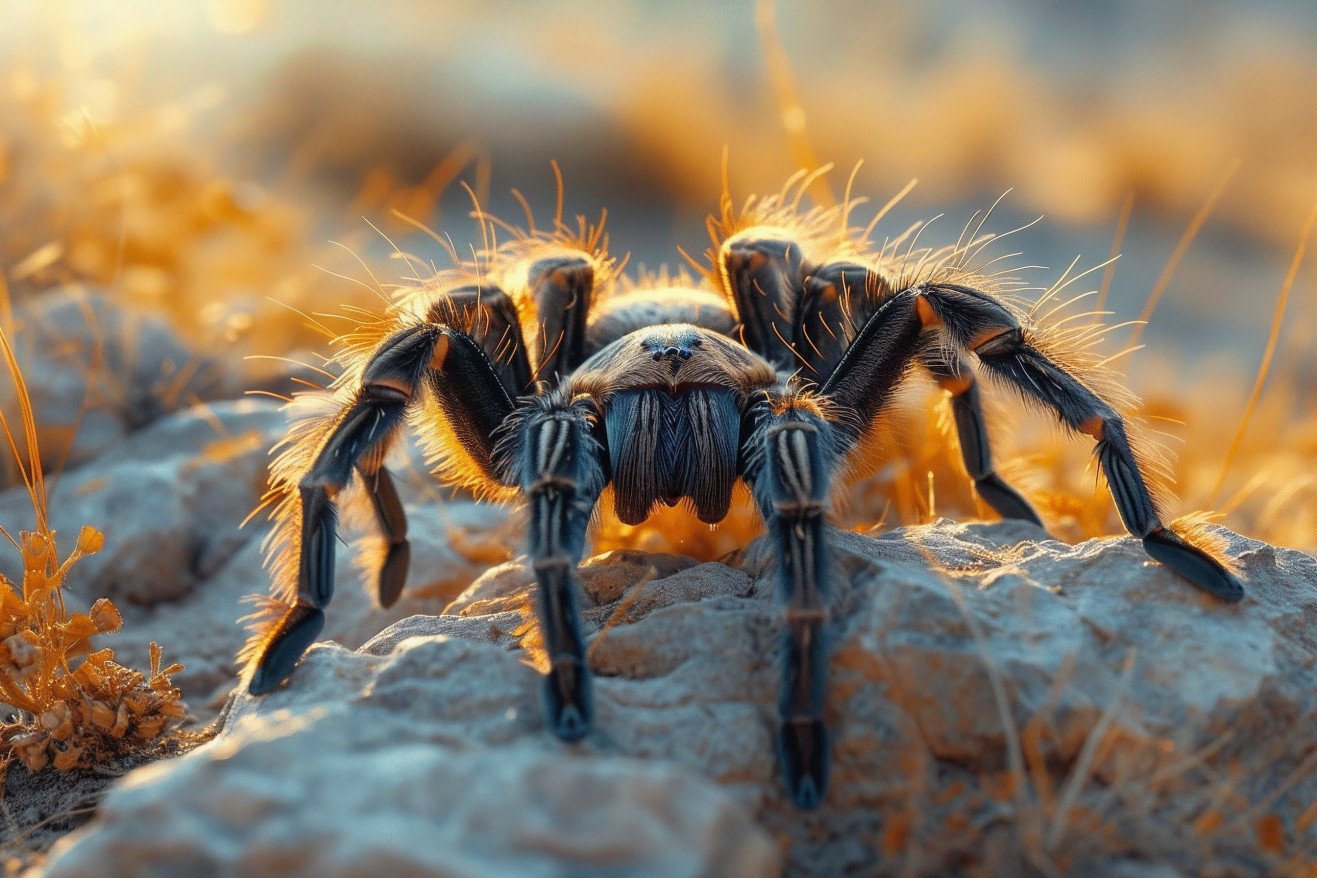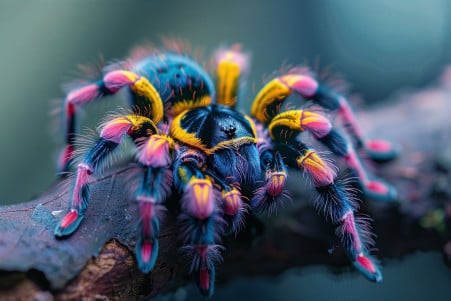Can Tarantulas Make Noise? The Truth About Spider Sounds
10 February 2024 • Updated 10 February 2024

In the wide world of animal sounds, can the mighty tarantula make noise? While tarantulas can’t growl, they can hiss by forcing air out of their book lungs. They also use stridulation, or the act of rubbing their legs against their abdomen, to make vibrations and sounds that help them communicate. These sounds are often described as hissing or buzzing.
In this article, we’ll take a deep dive into this interesting subject by looking at research from entomology, animal behavior, and acoustics to uncover the sounds tarantulas can make.
We’ll also look at scientific research on how arachnids communicate, the physical processes that allow them to make sounds, and how tarantulas and people perceive these sounds. By the end of this article, you’ll have a better idea of the many ways tarantulas interact with the world around them and the misconceptions about the sounds they make.
Can tarantulas make noise?
How Tarantulas Stridulate
Stridulation is a method of sound production that involves the rubbing together of certain body parts to create noise. Wikipedia explains that insects and some arachnids, including tarantulas, are known for stridulation.
For example, tarantulas like the Goliath tarantula stridulate by rubbing the bristles on their legs together. This is similar to the way a vinyl record works, in that it’s the friction of a needle that produces sound—tarantulas use “plectrums” to rub against ridged surfaces, creating vibrations that can be heard up to 15 feet away.
The sounds tarantulas make through stridulation can be used for a variety of purposes, including mating and defense. According to Empire Tarantula, the sounds tarantulas make, including hissing and stridulation, are often referred to as growling, but stridulation is a completely mechanical process, while growling involves the vocal cords.
In addition, the physical properties of the spider’s stridulating body parts can be affected by environmental factors like humidity and temperature, which can change the sounds the spider makes in terms of frequency and intensity.
Knowing how these sounds are made can help to clear up misunderstandings and give us a better understanding of tarantula behavior, including how they interact with and perceive their surroundings.
How Tarantulas Perceive the World: Vibration
Like other arachnids, tarantulas have evolved a complex sensory system that allows them to perceive their surroundings. This system includes slit sensilla, which are mechanoreceptors in the exoskeleton that allow them to sense vibrations in their environment. Slit sensilla are especially sensitive to surface waves and airborne vibrations, which means that tarantulas can sense and respond to the sounds and movements that are happening around them.
While tarantulas don’t construct the complex webs of orb-spinning spiders, their ability to sense vibrations remains crucial for their survival and communication. Tarantulas can detect and localize sounds, although it occurs in a manner that’s quite distinct from human hearing.
Research published in the Proceedings of the National Academy of Sciences has shown that spiders that create circular geometric webs sense vibrations through their webs, which they regard as an expansion of their sensory system. While this research is focused on spiders that create circular geometric webs, it has implications for understanding how tarantulas use similar vibrational cues to interact with their environment.
This sensitivity to vibration isn’t just important for navigation and finding food, it’s also an essential part of the complex behavioral interactions between tarantulas, including mating rituals and territorial displays. Understanding how tarantulas perceive their environment through their senses, especially their sensitivity to vibration, shows how complex these animals are and how important their senses are to their everyday lives.
Tarantula Defense: The Truth About the Myths
While some of the ways tarantulas defend themselves may be misinterpreted as aggressive or vocal behaviors by humans, tarantulas use a number of defense mechanisms. One of the most important is the release of urticating hairs.
These hairs, when released, create a cloud that can irritate and drive away potential predators. As explained by StatPearls, tarantulas use the hairs, which they dislodge from their abdomen, to protect themselves by causing irritation when they come into contact with skin, mucous membranes, or respiratory passages.
These are physical, not vocal, behaviors, and the idea that tarantulas growl is likely a result of their physical posturing and the vibrations caused by stridulation, which can be misinterpreted as vocal aggression. As a study in PMC notes, urticating setae are used not just for defense but also in the creation of egg sacs and molting mats, which shows that they have evolved to be useful in a number of ways.
By learning about the role and purpose of urticating hairs, we can better understand the evolutionary adaptation that helps these arachnids survive instead of continuing to believe in the myth of the growling tarantula. This understanding also helps us better appreciate the evolutionary implications of arachnid communication.
The Evolutionary Orchestra: Arachnid Acoustic Communication
The fabric of evolution is crafted with the development of acoustic communication in arachnids, which offers a glimpse into the detailed world of spider behavior. In the elaborate realm of spider mating, sound production is a crucial element of the process.
As the research shows, Acoustics.org notes that the purring wolf spider, for instance, uses vibrations and airborne sounds to communicate with potential mates. This has led to a better understanding of the complex acoustic communication of tarantulas, who, while not purring, have been found to have their own forms of vibrational communication.
A paper in Nature Communications delves into the evolutionary paths of sound communication, showing that many different species have evolved the ability to hear and produce sound independently.
The paper looks at the evolution of acoustic communication in a variety of species, including those in the Orthoptera order, and shows the potential and limitations of sound communication in tarantulas, who may not have a song in the way humans think of it, but have evolved a rich toolkit for communication through vibrations that has allowed them to survive and thrive.
The idea of sound in arachnid communication is a fertile area of research that shows a range of evolutionary adaptations. From finding mates to avoiding predators, the ability to make and hear sound, even in the most basic way, is an important part of a spider’s life.
As scientists continue to uncover the mysteries of tarantula communication, they not only learn more about the spiders’ lives but also come to understand the rich and complex evolutionary history that life on Earth has followed.
Shedding Light on Shadows: The Truth About Tarantulas vs. Myths
The negative cultural associations with tarantulas have long cast them in a negative light. As the Burke Museum points out, Hollywood has often portrayed tarantulas as dangerous monsters, which has helped to create a general fear of these spiders. This, combined with their scary appearance, has led to a number of myths about tarantulas, including the false idea that they growl, a mammalian behavior that’s often associated with threat and aggression.
According to the Springfield News-Leader, the tarantula’s image is a victim of misunderstanding, and despite their looks, tarantulas like the Aphonopelma hentzi found in Missouri are not a danger to people. As Tom’s Big Spiders observes, their portrayal in horror movies and on TV has only made people more afraid of them. However, social media and the rise of arachnoculture have started to change that by giving people a place to correct these misconceptions.
It’s important to continue to provide the public with accurate, engaging information about tarantulas to close the gap between what’s known in the scientific community and what’s believed in the popular imagination.
Only by dispelling myths will we be able to help people see tarantulas in a more accurate, less scary light. With time, we may even be able to help people appreciate tarantulas for who they really are as we learn more about their complex behaviors and the important roles they play in the ecosystems they inhabit.
Breaking the Sound Barrier: How Tarantulas Communicate
In our quest to demystify tarantula sounds, we learned that these amazing arachnids don’t growl, which is a common misconception. Instead, they stridulate and hiss to communicate a variety of messages, from mating to defense. We’ve delved into the details of stridulation, including the way tarantulas use specialized body parts to create vibrations. Their slit sensilla help them with their sensitive responses to these vibrations, which they use to interpret the world around them.
We’ve also looked at the way tarantulas use their defenses, including behaviors like the release of urticating hairs, which are often misunderstood by the people who witness them. Finally, by exploring the evolutionary history of arachnid acoustic communication, we’ve learned more about how these behaviors have evolved and what purposes they serve in different spider species.
The nuances and misunderstandings that surround tarantula behavior make a scientific understanding of them especially important. In the end, let’s appreciate the subtleties of tarantula communication and the ongoing research that continues to uncover the secrets of their amazing behaviors, revealing the silent orchestration that plays out in the world’s most remote places.


